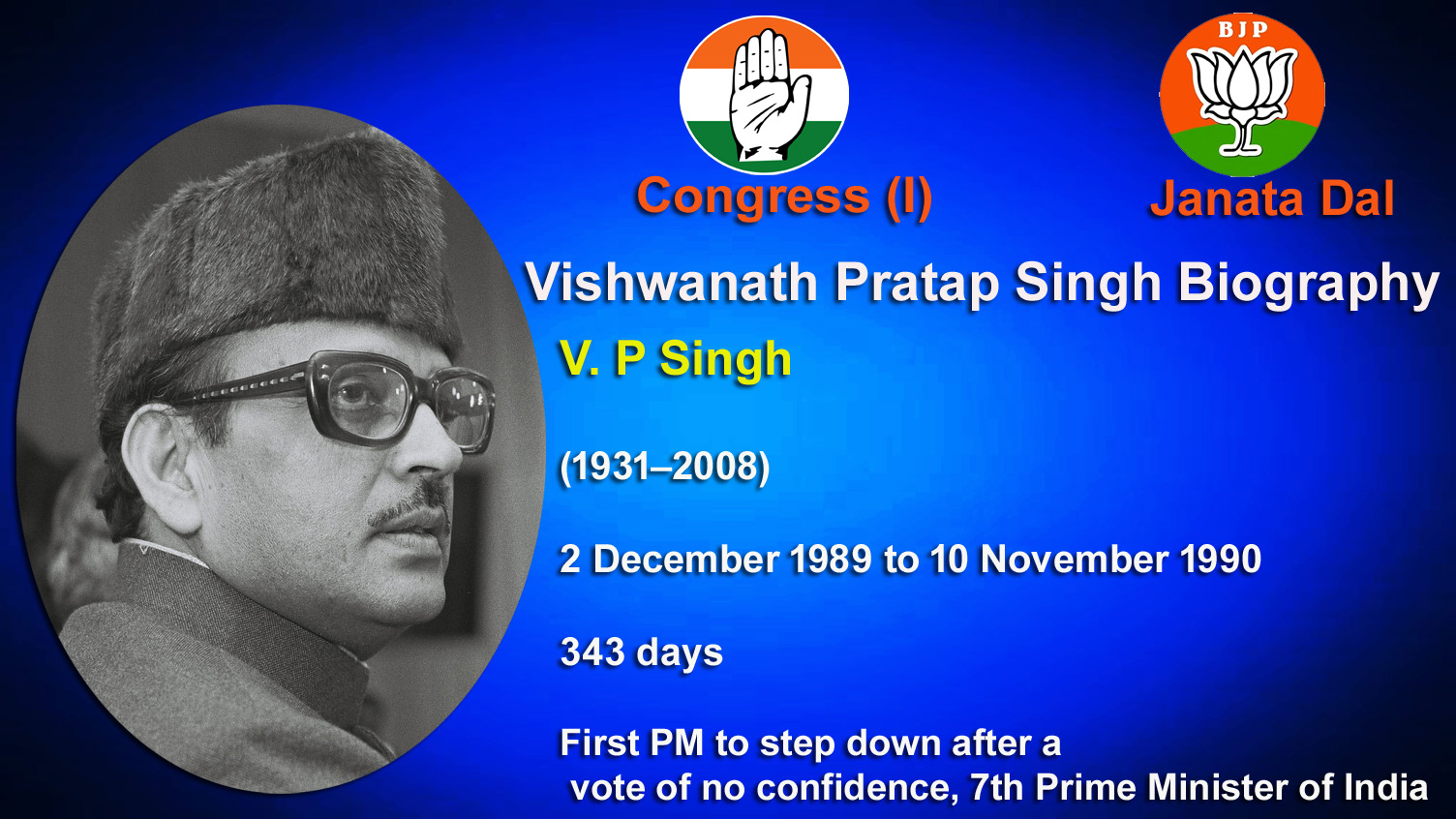vishwanath pratap singh, vishwanath pratap singh party, vishwanath pratap singh education, vishwanath pratap singh photo.
Vishwanath Pratap Singh – Biography:
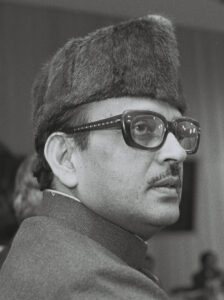
V. P. Singh
(1931–2008)
2 December 1989 to 10 November 1990
343 days
First PM to step down after a vote of no confidence
vishwanath pratap singh (VP Singh) – Born on June 25, 1931, Vishwanath Pratap Singh, also called V. P. Singh, departed from this life on November 27, 2008. In addition to becoming the 41st Raja Bahadur of Manda and the 7th Prime Minister of India from 1989 to 1990, he played important roles in Indian politics and society. Interestingly, he is the only prime minister from India who is descended from royalty.
He received his education at Fergusson College in Pune and Allahabad University. Following his election to the Uttar Pradesh Legislative Assembly in 1969, he became a member of the Indian National Congress party. He was elected to the Lok Sabha as a member of parliament in 1971. From 1976 to 1977, he was the Minister of Commerce.[Reference required] He was well-known for the Phoolan Devi gang encounter when he was appointed Chief Minister of Uttar Pradesh in 1980.
Singh was appointed to several cabinet positions in the Rajiv Gandhi ministry, including Minister of Defence and Minister of Finance. From 1984 to 1987, Singh also served as the Rajya Sabha’s leader. When the Bofors controversy surfaced while Singh was the Minister of Defence, he resigned from his position. He brought together different Janata Party factions to form the Janata Dal party in 1988. Singh became India’s eighth prime minister when the National Front, backed by the Bharatiya Janata Party (BJP), formed the government in the 1989 elections.
He carried out the Mandal Commission report for India’s backward castes while serving as prime minister, which sparked significant demonstrations against the legislation. In 1989, he also passed the Scheduled Caste and Scheduled Tribe Acts and drafted the Sixty-second Amendment. During his administration, Rubaiya Sayeed was abducted, and terrorists were freed on the ground. The legendary Hindu exodus from the Kashmir Valley took place in 1990. The BJP stopped supporting the National Front as a result of his opposition to the Ram Rath Yatra, and his government lost the motion of no confidence. Singh left his position on November 7, 1990. He served as prime minister for 343 days.
In the 1991 elections, Singh ran for prime minister on behalf of the National Front but lost. He expressed opposition to the 1992 demolition of the Babri Mosque. Singh remained a well-known person and political critic even after leaving his positions in politics in 1996. After receiving a multiple myeloma diagnosis in 1998, he withdrew from public life until the disease entered remission in 2003. But in 2008, he passed away from kidney failure and multiple myeloma complications. He was awarded all state honors.
Early Life and Political Journey:
V. P. Singh was educated at the Colonel Brown Cambridge School in Dehradun, Allahabad University, and Pune University. He came from a well-known Rajput family. In 1957, he joined the Indian Administrative Service (IAS) to start his political career. However, he quickly transferred to the Indian Police Service (IPS). His affiliation with the Congress party, where he was recognized for his administrative prowess, made his foray into politics easier.
Singh served a number of important roles in the years that followed, including Chief Minister of Uttar Pradesh from 1980 to 1982, and he kept moving up the Congress party ladder. However, he eventually left Congress due to ideological disagreements and worries about corruption inside the party.
Formation of Janata Dal:
A new chapter in V. P. Singh’s political career began with his exit from the Congress party. He was a key figure in the establishment of the Janata Dal, a political party that sought to bring together disparate opposition factions, in 1987. The Janata Dal gained the backing of various societal segments and grew to become a powerful movement.
Prime Ministership:
The Indian prime minister, V. P. Singh, took office on December 2, 1989. His administration had to deal with a number of difficulties, such as social unrest, economic problems, and growing pressure to carry out the Mandal Commission’s recommendations, which called for the appointment of OBCs (other backward classes) to positions in the government.
The implementation of the Mandal Commission recommendations by Singh’s government was a momentous decision that sparked national discussions and protests. Both proponents and opponents of the plan to set aside a portion of government positions for OBCs were expressed, further dividing Indian politics.
No-Confidence Motion and Resignation:
The Mandal Commission ruling set off a chain of events that resulted in the administration of V. P. Singh being voted out of office. In the Lok Sabha, the opposition parties, including the Bharatiya Janata Party (BJP), moved a resolution of no confidence. V. P. Singh became the first prime minister in Indian history to resign on a vote of no confidence on November 7, 1990, when the Lok Sabha experienced a dramatic turn of events and the government lost the vote.
V. P. Singh served as prime minister for 343 days, from December 2, 1989, to November 10, 1990, when he tendered his resignation. Singh’s legacy includes putting the Mandal Commission’s recommendations into practice, which had a long-lasting effect on Indian politics and social dynamics despite the controversy surrounding his government.
Later Political Career:
Following his resignation as prime minister, V. P. Singh remained involved in politics. In 1991, he founded the Jan Morcha, which in 1992 amalgamated with the Janata Dal. But as a result of shifting alliances and internal party dissension, his political career suffered ups and downs.
V. P. Singh continued to be a significant player in Indian politics in his senior years, supporting social justice and the advancement of underprivileged groups. On November 27, 2008, he departed from this life, leaving behind a complicated legacy that included both his accomplishments and his conflicts.
In Conclusion:
The life story of V. P. Singh depicts a complex political career filled with both difficulties and noteworthy accomplishments. Despite being brief, his tenure as prime minister had a lasting impact on Indian politics, particularly with the adoption of the Mandal Commission’s recommendations. The sequence of events culminating in his resignation subsequent to a vote of no confidence highlights the fluid and occasionally turbulent character of Indian politics during that period.
- Biography of jawaharlal nehru in english
- lal bahadur shastri biography in english
- Indira Gandhi Biography in Hindi
- Charan Singh biography – BIO
- Rajiv Gandhi biography
vishwanath pratap singh party – Short Biography
December 2, 1989 – November 10, 1990 | Congress, Janata Dal
Vishwanath Pratap Singh
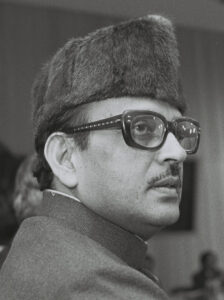
Shri V.P. Singh, the son of Raja Bahadur Ram Gopal Singh, was born in Allahabad on June 25, 1931. He attended the universities of Poona and Allahabad for his education. He married Smt. Sita Kumari on June 25, 1955, and they were blessed with two boys from their wedding.
An intelligent man, Shri V.P. Singh was proud to have founded Koraon, Allahabad’s Gopal Vidyalaya and Intermediate College. He held the position of Vice-President of the Students Union at Allahabad University after serving as President of the Students Union at Udai Pratap College in Varanasi from 1947 to 1948. He voluntarily contributed a well-established farm in the village of Pasna, District Allahabad, while actively participating in the Bhoodan movement in 1957.
He held positions in the All India Congress Committee, the Uttar Pradesh Legislative Assembly, and the Executive Body of Allahabad University during his political career. Shri V.P. Singh was the whip for the Congress Legislative Party from 1970 to 1971. He served as the Union Deputy Minister of Commerce from October 1974 to November 1976. From 1971 to 1974, he was a member of the Lok Sabha. Following that, he served as the Union’s State Minister of Commerce from November 1976 until March 1977. He continued his tenure in the legislature by serving one more term as a member of parliament (Lok Sabha), from January 3 to July 26, 1980.
Uttar Pradesh’s Chief Minister, Shri V.P. Singh, in office from June 9, 1980, till June 28, 1982. He also held positions in the Legislative Assembly of Uttar Pradesh from June 15, 1981 to July 16, 1983, and the Legislative Council of Uttar Pradesh from November 21, 1980 to June 14, 1981.
On January 29, 1983, Shri V.P. Singh was appointed Union Minister of Commerce. On February 15, 1983, he assumed additional duties as the Minister of Supply. As of July 16, 1983, he was still involved in politics as a Rajya Sabha member. He was chosen to be the President of the Uttar Pradesh Congress Committee on September 1, 1984. At last, Union Finance Minister Shri V.P. Singh took up the important position on December 31, 1984.
Vishwanath Pratap Singh, 7th Prime Minister of India

| Name | Vishwanath Pratap Singh |
| Date of Birth | June 25, 1931 |
| Place of Birth | Allahabad, India |
| Father’s Name | Raja Bahadur Ram Gopal Singh |
| Education | 1/ Cornell Brown Cambridge School, Dehradun 2/ Uday Pratap College, Varanasi 3/ Allahabad University 4/ University of Pune |
| Death | November 27, 2008 |
vishwanath pratap singh photo.
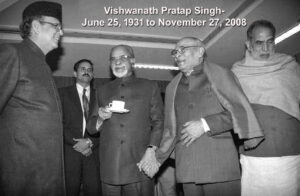
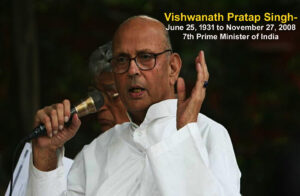
FAQs – Questions And Ans.
Here are 15 questions (Q) about Vishwanath Pratap Singh along with their corresponding answers (Ans):
- Q: When was Vishwanath Pratap Singh born?
- Ans: Vishwanath Pratap Singh was born on June 25, 1931.
- Q: What is V.P. Singh’s full name?
- Ans: Vishwanath Pratap Singh is commonly known as V.P. Singh.
- Q: Where was V.P. Singh born?
- Ans: V.P. Singh was born in Allahabad.
- Q: Who were V.P. Singh’s parents?
- Ans: His father was Raja Bahadur Ram Gopal Singh.
- Q: When did V.P. Singh get married, and to whom?
- Ans: V.P. Singh was married to Smt. Sita Kumari on June 25, 1955.
- Q: How many sons does V.P. Singh have?
- Ans: V.P. Singh has two sons.
- Q: What educational institutions did V.P. Singh attend?
- Ans: He attended Allahabad and Poona Universities for his education.
- Q: What did V.P. Singh establish in Allahabad?
- Ans: V.P. Singh was the proud founder of Gopal Vidyalaya, Intermediate College, Koraon, Allahabad.
- Q: In which year did V.P. Singh actively participate in the Bhoodan movement?
- Ans: V.P. Singh actively participated in the Bhoodan movement in 1957.
- Q: When was V.P. Singh the Chief Minister of Uttar Pradesh?
- Ans: V.P. Singh served as the Chief Minister of Uttar Pradesh from June 9, 1980, to June 28, 1982.
- Q: What political positions did V.P. Singh hold in the Legislative Assembly of Uttar Pradesh?
- Ans: V.P. Singh was a Member of the Legislative Council (November 21, 1980 – June 14, 1981) and the Legislative Assembly (June 15, 1981 – July 16, 1983) of Uttar Pradesh.
- Q: When did V.P. Singh become the Union Finance Minister?
- Ans: V.P. Singh became the Union Finance Minister on December 31, 1984.
- Q: What additional charge did V.P. Singh hold as the Union Minister of Commerce in 1983?
- Ans: In 1983, V.P. Singh held the additional charge of the Department of Supply.
- Q: When was V.P. Singh elected as the President of the Uttar Pradesh Congress Committee?
- Ans: V.P. Singh was elected as the President of the Uttar Pradesh Congress Committee on September 1, 1984.
- Q: What role did V.P. Singh play in the Students Union at Udai Pratap College, Varanasi?
- Ans: V.P. Singh served as the President of the Students Union at Udai Pratap College, Varanasi, in 1947-48.
1. How long did Vishwanath Pratap Singh served as the Prime Minister?
Ans: Vishwanath Pratap Singh served as the seventh President of India from December 2, 1989 to November 10, 1990. His prime ministership was 343 days.
2. Why did Vishwanath Pratap Singh resign as defence minister in Rahul Gandhi’s cabinet?
Ans: Accusing Rajiv Gandhi of corruption over Bofors scam, Vishwanath Pratap Singh resigned as defence minister on July 17, 1987.
3. When and where was Vishwanath Pratap Singh born?
Ans: Vishwanath Pratap Singh was born on June 25, 1931 into a Hindu Rajput Zamindar family.
4. When did V.P. Singh died and in what age?
Ans: Vishwanath Pratap Singh passed away on November 27, 2008 at Indraprastha Apollo Hospital in New Delhi at the age of 77 after suffering from cancer and kidney disease for over a decade.
